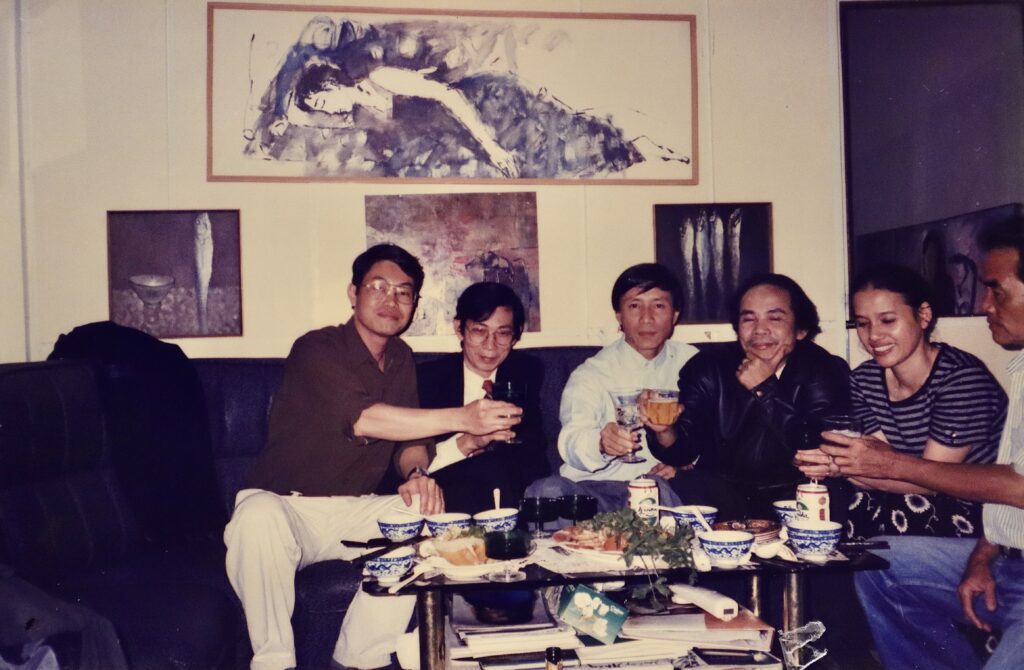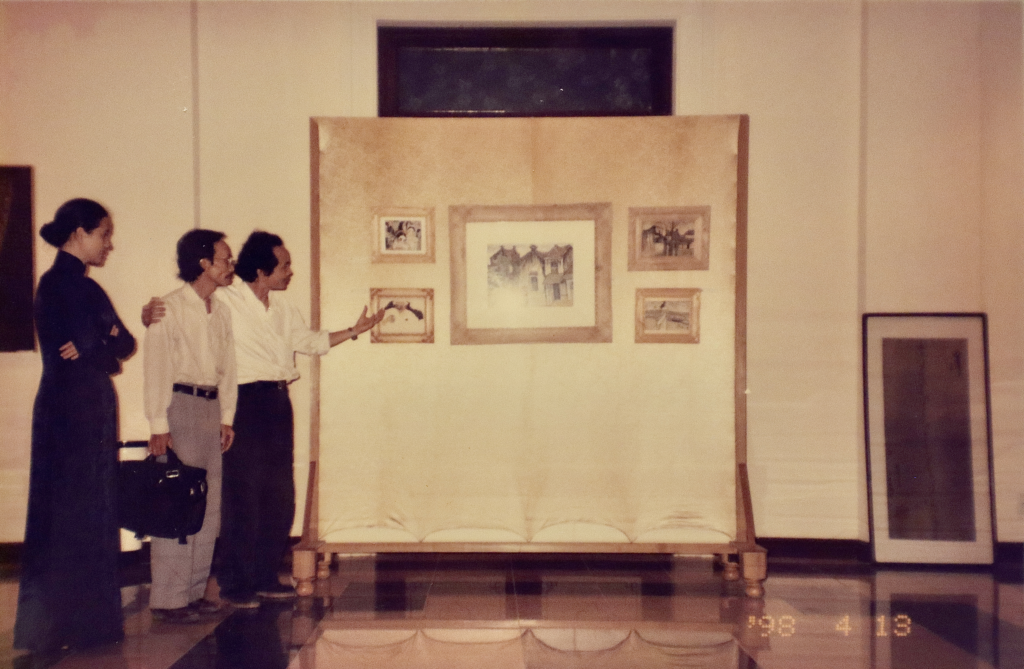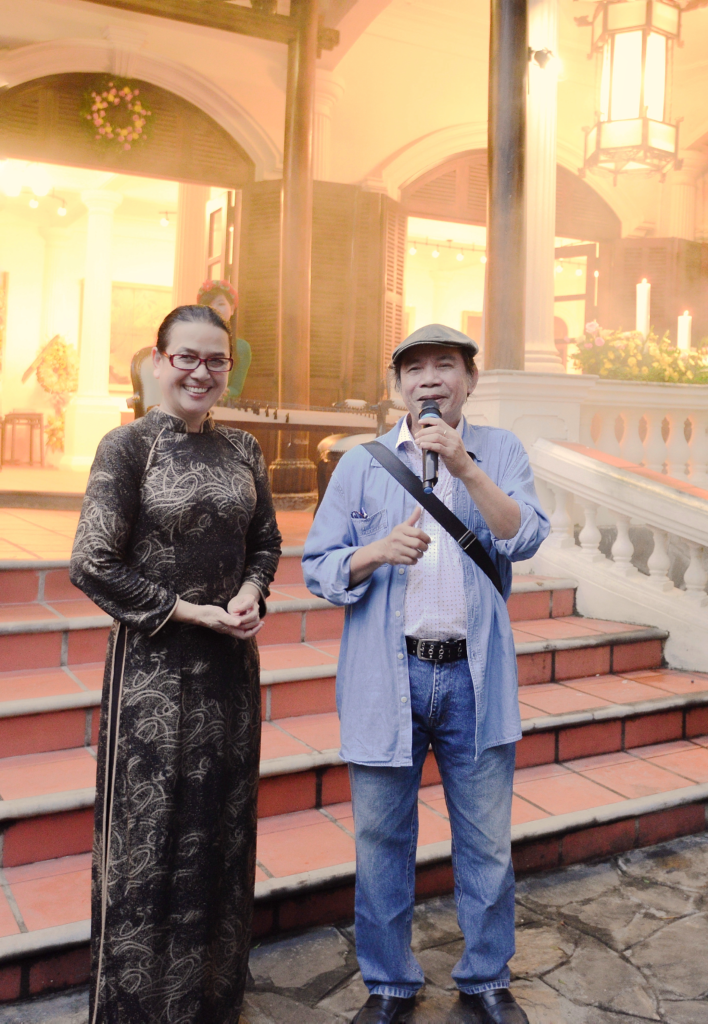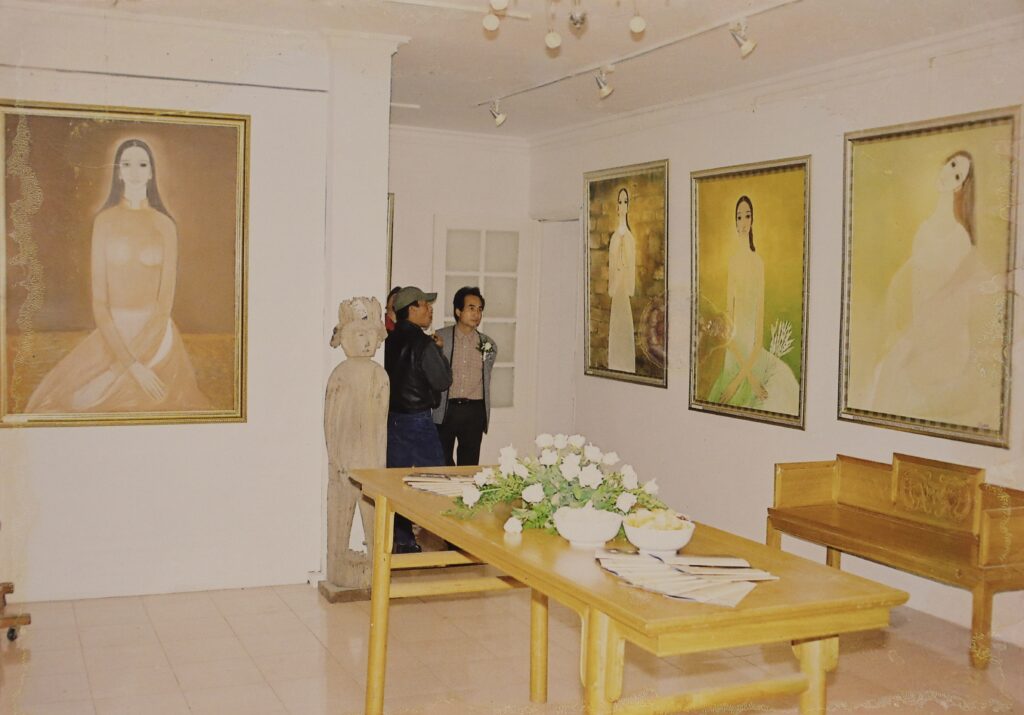Boi Tran, Ladies and Flowers
Author, Journalist, Musician Nguyen Trong Tao

BOI TRAN, LADIES AND FLOWERS
BỘI TRÂN, THIẾU NỮ VÀ HOA
On the very last day of the year of the Monkey, I passed by Minh Chau Art Gallery at 7 Ly Dao Thanh, Hanoi, not only to contemplate the masterpieces of leading artists such as Nguyen Phan Chanh, Bui Xuan Phai, Nguyen Tu Nghiem, Nguyen Sang… displayed for sale as usual, or visit the little young owner Minh Chau I am dear to but feast my eyes on her mother's paintings displayed to art lovers in Hanoi.
Một ngày cuối năm Con Khỉ, tôi ghé vào Gallery Minh Châu số 7 Lý Ðạo Thành, Hà Nội, không phải để chiêm ngưỡng tranh của các bậc thầy hội hoạ Nguyễn Phan Chánh, Bùi Xuân Phái, Nguyễn Tư Nghiêm, Nguyễn Sáng... vẫn thường được bày bán ở đây, hay để thăm cô chủ nhỏ Minh Châu quen thân từ trong Huế như mọi lần, mà để xem tranh của mẹ cô vừa mang từ Huế ra trình làng với giới hâm mộ hội hoạ đất Hà Thành.

Brilliantly—coloured flower baskets for the exhibition were still freshly scented, and the art gallery was full of art lovers. Two floors were full of artworks and their colours. The locals and the foreigners paid attention to the paintings and discussed with each other whilst cameras captured those precious moments. Sowing the seeds of the profound impression to the public is images of ladies and flowers
Những lẵng hoa mừng triển lãm vẫn còn tươi. Người đến xem tranh vẫn còn đông. Người ta và người nước ngoài xem tranh và xem nhau. Máy ảnh và camera lưu giữ những kỷ niệm. Cả hai tầng nhà tràn ngập sắc và hình. Ấn tượng mạnh nhất gieo vào người xem là thiếu nữ và hoa.

I have known her, the artist of these paintings, for a long while since I lived in Hue. During that period of years, Boi Tran, one of the earliest pioneers, opened the first privately owned art gallery business at Saigon Morin Hotel, nearby the charming Perfume River. The grand opening of Boi Tran Art Gallery drew the attention and participation of artists from the North to the Central, and Poet Nguyen Khoa Diem, Vietnam's Minister for Culture and Information, took part as a principal speaker and did the ribbon-cutting ceremony. I understand the gratitude and appreciation of the Minister towards the latest event, as since then, it laid the foundations for the Vietnamese art market, especially for heritage preservation along with palaces, pagodas, temples, and tombs. Thanks to her immense enthusiasm for art, Boi Tran started to paint. Her earliest teachers included Nguyen Trung, Truong Be and Trinh Cong Son. Those prominent teachers accompanied her to paint at her own house or her garden on Thien An Hill. She painted them and vice versa. Depictions were mostly executed on oil or lacquer. Perhaps, by that, do the early paintings of Boi Tran bear some resemblance to Nguyen Trung's? Taking it into more conscientious consideration, apparent signs of femininity feature and give prominence to her artworks. In addition, the reason why Boi Tran's paintings strangely stimulate and awaken the audiences' reminiscences of the nostalgic and elegant Hue ladies…
Tôi quen biết tác giả của những bức tranh ấy đã khá lâu, hồi tôi còn ở Huế. Dạo ấy Bội Trân là một trong những người can đảm mở gallery tư nhân đầu tiên, một gallery lớn ngay nơi tầng một của khách sạn Morin cạnh bờ sông Hương thơ mộng. Cuộc khai trương Gallery Bội Trân có mặt nhiều hoạ sĩ Bắc — Trung — và nhà thơ Nguyễn Khoa Ðiềm lúc ấy là Bộ trưởng Bộ Văn hoá—Thông tin cắt băng khai mạc. Tôi hiểu sự trân trọng của người Bộ trưởng đối với cái sự kiện mới mẻ này bởi từ đấy có thể mở ra một thị trường tranh cho thành phố du lịch đặc biệt mang trong nó một di sản văn hoá thế giới với những cung điện, chùa chiền, đền đài, lăng tẩm đang được bảo tồn. Từ niềm đam mê hội hoạ ấy, Bội Trân đã vẽ. Những người thầy đầu tiên của chị là hoạ sĩ Nguyễn Trung, Trương Bé hay Trịnh Công Sơn. Những người thầy nổi tiếng ấy đã cùng Bội Trân vẽ tranh tại tư gia của chị hoặc bên những đồi thông vi vút bên hồ Thủy Tiên. Chị vẽ họ và họ vẽ chị. Vẽ người và vẽ cảnh. Vẽ sơn dầu và vẽ sơn mài. Có lẽ vì thế mà đôi bức tranh thuở ban đầu của Bội Trân phảng phất bút pháp Nguyễn Trung? Nhưng xem kỹ, đã thấy những dấu hiệu nữ tính nổi trội trong tranh của chị. Và một điều lạ nữa, là không hiểu vì sao những bức tranh của chị lại lôi dắt người xem trở về với dáng vẻ u hoài và kiêu sa của xứ Huế cố đô...

Boi Tran told me she had never painted as much as in the last two years. I recognized the unbearably intense suffering she experienced. The sudden passing of a son she loved most in the world. Her handsome, obedient, kind and enthusiastic son, during his senior year of university in America, all of a sudden, went to his last resting place because of the sacrifice of his life to save his friends in the Pacific Ocean. Boi Tran kept the most beautifully restored wooden house made of jackfruit trees to worship him while living nearby, in a restored minority place. The praying area was elegantly decorated with photos of her son and family, nature and friends. On the day to celebrate a mass for the peace of his soul in Hue, there weren't any white roses left in Hanoi as those had been delivered to Hue for a mother who was suffering the loss of her son. "Those days, I would be dying without painting"—Boi Tran expressed in sorrow. I eyed the paintings. Ladies with enormous eyes opened to stare into space, bend down with 'Queen of The Night' flowers or eyes closed to pray like hers. Twelve lacquer paintings of ladies in 60x120cm dimensions are applied by silver and gold without any vividly vibrant colour tone yet deepened by the green moss of the citadel or velvety brown of Thien An Hill. Only if a baby boy appears the tone becomes brighter in the melancholic setting. Hence, it interprets her deep reminiscences toward his son.
Bội Trân kể với tôi rằng, chưa bao giờ chị vẽ nhiều như hai năm qua. Tôi biết chị muốn nói đến một nỗi đau khủng khiếp mà không bao giờ vượt qua được. Ðó là sự ra đi đột ngột của đứa con trai cưng nhất đời chị. Một đứa con trai thật đẹp, thật ngoan hiền, thật giàu mơ mộng, đang học Ðại học năm thứ tư ở Mỹ bỗng vĩnh viễn qua đời trong một cuộc cứu bạn bên kia biển Thái Bình Dương. Chị dành cả ngôi nhà rường làm bằng toàn gỗ mít đẹp nhất trong khu nhà vườn bên đồi Thiên An để thờ con, còn chị thì ở ngôi nhà sàn Hoà Bình bên cạnh. Chung quanh ngôi nhà thờ treo toàn ảnh con trai chụp với gia đình, thiên nhiên và bè bạn. Trong ngày lễ cầu siêu cho con trai tại Huế, Hà Nội như không còn hoa hồng trắng, bởi những bông hồng trắng đã được chuyển vào Huế cho người mẹ mất con, là chị. “Những ngày ấy nếu không vẽ, chắc Bội Trân sẽ chết mất”—chị nói, giọng vẫn nặng trĩu nỗi đau hai năm rồi, khó mà chia sẻ được. Tôi nhìn những bức tranh. Những thiếu nữ mắt mở to nhìn về xa xăm, cúi xuống với hoa quỳnh hay khép lại nguyện cầu sao mà nó giống đôi mắt chị. 12 bức sơn mài 60×120 cm vẽ thiếu nữ, không một bức nào ánh màu sặc sỡ dù vẫn có chất liệu vàng kim, mà tất cả đều trầm xuống cùng với rêu phong hoàng thành hay đất đồi Thiên An hoá thạch. Chỉ khi trong tranh chị xuất hiện đứa bé trai được mẹ bế bồng thì tươi sáng mới xuất hịên trên cái nền u trầm ấy, và ta đọc thấy trong tranh chị một tình yêu con đến phải nuốt lệ.

'Lady on the Peak of a Rock' caught my attention, her chin resting on her hands resting on her knees, eyes wide open looking into the infinity. A painting with a unique layout, different from other paintings of ladies in the art gallery. Moreover, I learned that it was Boi Tran's painting of her daughter Minh Chau sitting by the sea in the US, waiting for people to find her brother's body. Such extreme repressions are apparently expressed through her brushes. Dozens of flower paintings are depicted afterwards. Queen of the night and lotuses are her two most favourable. She paints while cherishing scarce moments of blooming and dying. It's her longing to hold on to every moment of beauty; she wants to take care of the beauty. I look at the lotus in her paintings which are strangely evolving. Sometimes it is like a candle lit on the lake surface at night or tightened into a bunch like burning incense sticks... The flowers illustrate something sacred.
Tôi chú ý một bức tranh thiếu nữ ngồi bên mỏm đá, cằm tì trên hai bàn tay đặt trên hai gối chân khép lại, mắt mở to nhìn về vô định. Một bức tranh có bố cục khá độc đáo, khác hẳn với các tranh thiếu nữ khác trong phòng tranh. Và tôi được biết đấy là bức tranh Bội Trân vẽ cô con gái Minh Châu đang ngồi bên vụng biển ở Mỹ đợi chờ người ta kiếm tìm thi thể của em trai đang chìm dưới biển. Những dồn nén như vậy đã được Bội Trân dồn lên cây cọ. Vài chục bức tranh Hoa đã được ra đời như vậy. Hoa quỳnh và hoa sen là hai loài hoa được Bội Trân yêu mến nhất. Chị vẽ như nâng niu từng khoảnh khắc nở và tàn ngắn ngủi của phận kiếp quỳnh hoa. Ðấy là chị muốn níu giữ từng khoảnh khắc của cái đẹp, chị muốn cứu cái đẹp. Tôi nhìn những bông sen trong tranh chị và thấy những bông hoa biến hoá lạ lùng. Khi thì sen như nến thắp trên mặt hồ đêm, khi thì sen được bó lại thành từng bó như những bó nhang đang cháy... Có điều gì đó thật thiêng liêng gửi gắm trong hoa.

"Painters paint not to speak, but to be silent." - Art critic Thai Ba Van. He also added: "What we study in a work of art is the deep underneath of the iceberg that Hemingway once woke up." I totally agree with him when looking at Boi Tran's paintings, yet some of the beauty catches our eyes at very first sight. The first thing I feel when observing her paintings is elegance—a transparent beauty of colour and pure innocence of figure. Instinctive charm appears before both technical virtuosity and experience. It is an ability that one cannot become an artist without.
“Hoạ sĩ vẽ không phải để nói, mà là để im lặng”. Nhà phê bình mỹ thuật Thái Bá Vân nói thế, và ông cũng nói thêm: “Cái ta đọc thấy nơi tác phẩm nghệ thuật, là nằm ở phần ngầm của tảng băng mà Hemingway đã một lần thức giấc”. Tôi đồng ý với ông khi tôi xem tranh Bội Trân, nhưng có những cái đẹp ngay từ đầu đã đập thẳng vào trực giác của con người. Cái điều tôi thấy đầu tiên khi xem tranh của chị là Ðẹp. Một vẻ đẹp trong suốt của màu, và một vẻ đẹp ngây thơ của hình. Cái vẻ đẹp đầy tính bản năng đã hiện ra trước cả sự điêu luyện của kỹ thuật và trải nghiệm. Ðấy là một khả năng mà nếu không có nó, người ta không thể trở thành nghệ sĩ.
Previously, I described Boi Tran as a Hue talented woman; at that time, she had not exhibited her paintings. A person was ready for whatever fate offered to exist as a celebrity in the centre of the ancient capital. She built a cultural garden nestled by the side of Thien An Hill herself, established the Bamboo and Rattan Handcraft Art Company, and held a Culinary Fair for thousands of people at Christmas last year. For now, without an official degree from any art school, she still has a beautiful art gallery exquisitely displayed in the downtown of the capital city. I asked: "Boi Tran worked too much, don't you feel tired?". Gently smiled, "Yes,... It is my trait, I get used to being tired to be happy!", she answered. I once again looked at the artworks of ladies and flowers and suddenly found that Boi Tran was right. After working with enthusiasm, one finds pleasure in themselves.
Trong một bài viết trước đây, tôi có gọi Bội Trân là một Tài-Nữ-Huế, khi ấy chị chưa triển lãm tranh. Ðấy là một con người vượt qua số phận để tồn tại như một người nổi tiếng ngay giữa đất cố đô. Chị sinh ra ở Quảng Trị gió Lào và cát trắng vào năm Con Gà 1957. Vào Huế đi học, lấy chồng rồi một mình nuôi con, một mình mở gallery ở Huế và ở Hà Nội, một mình dựng lên một khu nhà vườn văn hoá bên đồi Thiên An, một mình mở công ty mỹ nghệ mây tre, và từng tổ chức cả một Hội chợ quê cho Noel năm trước. Và giờ đây, dù không qua một trường lớp hội hoạ chính quy nào, chị vẫn có cả một phòng tranh đẹp bày tự tin giữa thủ đô văn hiến. Dù nhà chỉ còn hai mẹ con, mẹ ở Huế, con ở Hà Nội, nhưng chị vẫn ước mơ trong một vài năm tới sẽ biến khu nhà vườn của mình ở Huế thành một trung tâm thu hút khách du lịch, với những dịch vụ văn hoá, sản xuất hàng mỹ thuật, trưng bày triển lãm và hội thảo... Tôi hỏi: “Bội Trân làm nhiều thế, không thấy mệt hay sao?”, chị cười nhỏ nhẹ: “Dạ thưa... Cái tính em nó rứa, quen lấy mệt làm vui rồi anh ạ!”. Tôi ngước nhìn lần nữa những bức tranh thiếu nữ và hoa, chợt thấy Bội Trân đã nói đúng, sau những lao động sáng tạo, con người đã tìm được niềm vui cho chính mình.
Perfume River Journal, No. 192, Published in February 2005.
Tạp Chí Sông Hương, Số 192, 02/2005.

